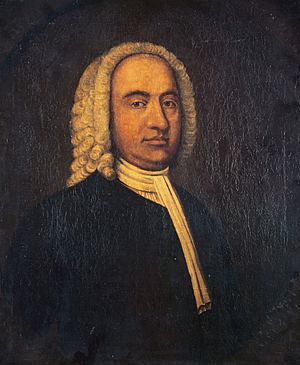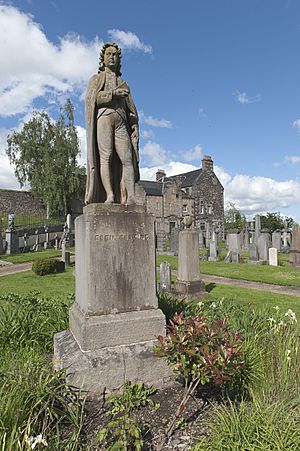Ebenezer Erskine facts for kids
Quick facts for kids
Ebenezer Erskine
|
|
|---|---|

Ebenezer Erskine (unknown artist) National Galleries Scotland
|
|
| Born | 22 June 1680 |
| Died | 2 June 1754 (aged 73) |
| Nationality | Scottish |
| Education | University of Edinburgh |
| Occupation | Pastor, Theologian |
| Theological work | |
| Tradition or movement | (1) Church of Scotland (2) Associate Presbytery/ Secession Church (3) Burgher Seceder |
Ebenezer Erskine (born June 22, 1680 – died June 2, 1754) was an important Scottish minister. He played a big part in starting a new church called the Secession Church. This church was formed by people who disagreed with some things happening in the main Church of Scotland.
Contents
Early Life and Ministry
Ebenezer's father, Henry Erskine, was also a minister. He was forced to leave his church in 1662 and was even put in prison. Ebenezer and his brother Ralph were born during this difficult time. After a big change in government in 1688, his father became a minister again.
In 1703, Ebenezer finished his studies at the University of Edinburgh. He then became a minister in a town called Portmoak. A year later, he married Alison Turpie. They lived in Portmoak for 28 years. In 1731, he moved to lead a church in Stirling.
The Secession Church Begins
Disagreements and Protests
Ebenezer Erskine and some other ministers faced problems with the Church of Scotland. In 1722, they were criticized for defending certain religious ideas from a book. Later, in 1733, Ebenezer preached a sermon about how ministers were chosen. This sermon caused more trouble.
He believed that local church members should have more say in choosing their minister. But the Church of Scotland's leaders disagreed. They supported a system where powerful landowners could choose ministers, which was called "lay patronage."
Suspension and New Church
Ebenezer tried to explain his views to the church's main meeting, called the General Assembly. But they sided with his critics. Because he kept speaking out, he and three other ministers were suspended from their duties in November 1733.
To protest this decision, these suspended ministers decided to form their own church group. They called it the "Associate Presbytery." This was the start of the Secession Church. In 1739, the Church of Scotland asked them to come back, but they refused. The next year, they were officially removed from the Church of Scotland.
Growth and Division
Many people joined the new Associate Presbytery. The church grew quickly. However, in 1747, the Associate Presbytery itself split into two groups. This happened because of a disagreement over a new oath required for people in certain towns.
Ebenezer Erskine joined the group known as the "Burgher" section. He became their professor of theology, teaching new ministers. He continued to preach to a large church in Stirling until he died. He was known as a popular and strong preacher. He always acted with honesty and courage based on his beliefs.
Lasting Influence
Most of Ebenezer Erskine's published writings are his sermons. His ideas and teachings were very important. They influenced many people, including those in the Dutch Reformed Church.
In the United States, some parts of the Secession Church joined with another group in 1782. They formed the Associate Reformed Presbyterian Church. This church still exists today. It runs Erskine College and Seminary in South Carolina.
Family Life
Ebenezer Erskine's daughter, Jean, married a minister named Rev Robert Fisher. Rev Fisher was a minister in Glasgow.
Free Gardener
Ebenezer Erskine was also a member of a group called the Order of Free Gardeners. He joined the Dunfermline Lodge of Free Gardeners in 1722. It's interesting that after he joined, his sermons started to include many examples and stories about gardening.
See also
- Erskine College
- Thomas Mair


